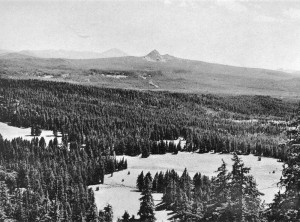The Geology of Crater Lake National Park, Oregon With a reconnaissance of the Cascade Range southward to Mount Shasta by Howell Williams
The Foundations of Mount Mazama
The Union Peak Volcano
The Summit Cone
After the main lava shield had been built, a small pyroclastic cone developed in the summit crater. The bedded ejecta of which this cone is composed abut sharply against the surrounding lavas in such a way as to suggest that the original crater was steep-walled and deep. Except on the north side, the limits of the cone are easy to locate and enclose an approximately oval area, 2/3 by 1/2 mile across, elongated parallel to the general trend of the Cascade Range.
Most of the cone is made up of well bedded, pale-buff lapilli tuff and tuff breccia, in which fragments up to 18 inches in diameter lie in a calcareous, sand-like matrix of tuff. Nearer the summit pinnacle, the ejecta become increasingly scoriaceous and ultimately give way to beds of black “cinders” and agglutinate. The earlier eruptions of the summit cone must therefore have been of Strombolian type, the magma being erupted in viscous, incandescent clots, some of which when they fell were sufficiently pasty to adhere to neighboring fragments. Gradually, as activity continued, the eruption of bombs and lapilli of viscous magma diminished, and fine ash and solid fragments of old lava were blown out at lower temperature.
Around the periphery of the cone the dips of the ejecta are low, but inward they steepen beyond the normal angle of repose for such materials. A similar inward increase in the dip of the tuffs may be noted on the summit cone of Mount Thielsen. In both cones, the disturbances must be attributed to intrusion of central plugs of lava.
|
Plate 4. Fig. 1. The Union Peak volcano, looking south from the Rim Road near the Watchman. The long, gentle slopes of the volcano are of lava; the summit pinnacle represents the filling of the central conduit. Between the gentle lava slopes and the central plug, and largely concealed by talus, are the eroded remnants of a tuff cone that formerly occupied the crater. Mount McLoughlin, another High Cascade cone, shows faintly in the distance. The foreground is part of Mount Mazama. |
***previous*** — ***next***


